The Greatest Game José Fernández Ever Pitched
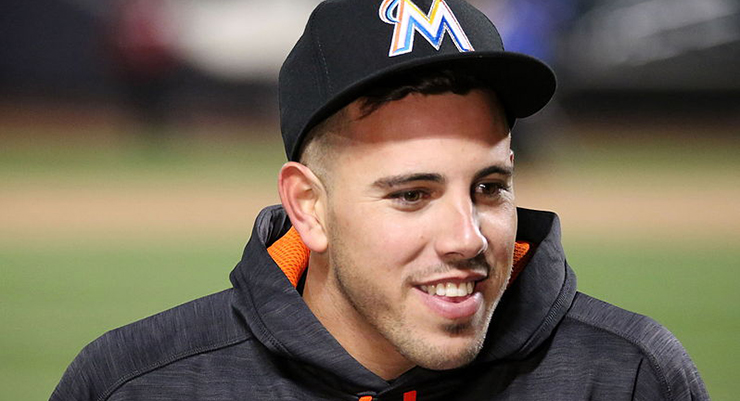
Jose Fernandez was an elite pitcher before he died in late September (via Arturo Pardavila III)
”He who kisses joy as it flies by will live in eternity’s sunrise.”
― William Blake
2016 was a rough year on all fronts, but in the small corner of the world populated by baseball players, employees, fans and media, no day was worse than the morning of Sunday, Sept. 25, when the death of José Fernández first hit the airwaves and cyberspace. If you are reading this, I don’t need to tell you of the shock and horror of that moment; you are already familiar with the grief that overwhelmed all who ever saw Fernández pitch, heard him speak, or knew him as a man.
But this piece isn’t about grief. It is a piece of about joy and celebration. It’s about honoring the legacy of the greatest right-handed pitcher of his generation, a guy who was probably on his way to the Hall of Fame if he stayed healthy.
It’s about remembering the greatest start of his all-too-short career.
How did I go about objectively determining such a thing? I can’t claim to have watched all of Fernández’s starts, though I watched a great many One way would be to look at innings pitched and runs allowed, although we all know how much variance can go into those things in a one-game sample size. Perhaps weighing strikeouts and walks? No, a pitcher is at least in part responsible for some of the contact he gives up.
There is, in fact, a holistic measure that attempts to quantify the quality of a pitcher’s individual start: Game Score. Developed by Bill James back in the 1980s, Game Score assigns weight to various elements such as innings pitched, hits, walks, outs, strikeouts, runs allowed and home runs, to get a sense of a pitcher’s performance. James had every pitcher start at 50 points, and each event would either add to or subtract from that baseline score.
It’s not a perfect method; after all, some hits aren’t a pitcher’s responsibility, while some outs aren’t, either. However, it probably does as good a job of representing a pitcher’s one-game dominance as anything.
Last spring, Tom Tango refined James’ formula, lowering the starting point to 40 to move the baseline toward replacement level rather than an average start. (If you leave the game early due to injury, you shouldn’t be heavily penalized for that.) He also assigned more weight to events like walks, and penalizes home runs more heavily than other hits. In this new estimation, the Three True Outcomes have more bearing on a pitcher’s score than they did in the formula’s previous incarnation.
So what game does Game Score 2.0 consider to be José Fernández’s best? In a cruel twist of poetic tragedy, it is his last outing that comes out on top: Tuesday, Sept. 20, 2016 at home against the Washington Nationals. Here is Fernández’s line from that game:
| IP | Pitches | BB | K | HR | H | R | GSv2 |
|---|---|---|---|---|---|---|---|
| 8.0 | 111 | 0 | 12 | 0 | 3 | 0 | 93 |
For reference, the highest Game Score 2.0 recorded in 2016 was 103, logged by the Phillies’ Vince Velasquez at home against the Padres on April 14, and also by the Giants’ Madison Bumgarner at home against the Diamondbacks on July 10. Fernández didn’t have the best game of the year, but he was up there.
I watched this one live, and you could tell how dialed in Fernández was that day. Teammates even quoted him afterward, relating that he had told them it was the best game he’d ever pitched. Fernández was right in sync with Game Score 2.0.
So, to remember Fernández’s greatness, I want to tell the story of that game and of what made it, and Fernández, so special.
Top of the 1st: Turner (6-3), Drew (2B), Harper (F7), Rendon (F5); 19 pitches
That ineffable radiance emanating from Fernández is on display before the game even starts. As Fox Sports Florida’s Rich Waltz and Preston Wilson preview the day’s action, a field camera captures Fernández warmly embracing Marlins bullpen coordinator Jeff Urgelles, the final moment before Fernández shifts fully into game mode.
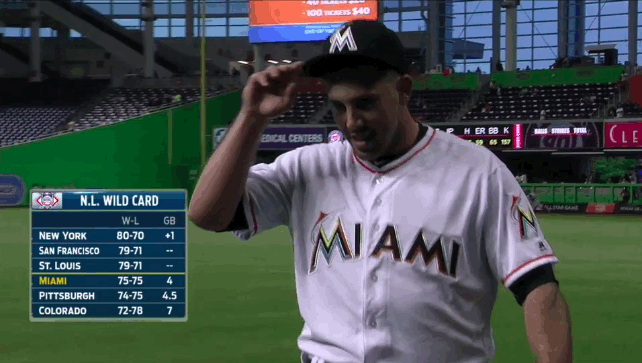
Just before the hug, he looks up into the crowd, smiles widely, and gestures toward someone. The camera doesn’t give us the reverse angle, but it is obviously someone who is there to cheer him on, to lift him up. My first thought was that it was Fernández’s mother, Maritza, ever present in Marlins Park when Fernández took the hill. But she always sit along the third base line; Fernández was gesturing toward the first base side of the diamond. I’d like to think it was one of the passionate fans on whose energy Fernández constantly fed. There is a reason that Fernández’s career ERA at home sat at 1.49: the fans got him going.
To begin the game, Fernández served up a 92-mile-per-hour fastball to Trea Turner. Fernández threw a fastball as the first pitch of the game in every start of his career. They averaged 94 mph. Fernández took it a little easy on Turner, and Turner made Fernández nervous. He put the ball where he wanted on the outside corner, and Turner made solid contact the other way. The pitch landed in foul territory..
No matter. Fernández started pressing the gas on the second pitch, cooking in a 95.5-mph four-seamer off the outside corner for ball one. Three pitches later, Turner tapped a grounder to Adeiny Hechavarria for out number one.
If there was one weakness to Fernández’s game in 2016, it was line drives that dropped in for singles and doubles. An endless source of debate, of course, is to what degree a pitcher has control over line drive rates. A line drive is the batted ball type whose edges bleed at both ends the most. In the case of Fernández, his 92-mph average exit velocity on fly balls and line drives was about league-average. The line drives that did fall for hits probably weren’t completely his fault, despite playing in front of an average defense and mostly in a neutral park for air balls. As Statcast gets better, and analysts improve our ability to analyze contact, we’ll get closer to the truth of what Fernández was responsible for.
Stephen Drew then stepped into the box. Drew was giving Daniel Murphy the night off at second base, and Fernández left a 2-1 fastball over the inner half, which Drew promptly smacked for a double.
Despite the greatest single-season strikeout rate in baseball history by a starting pitcher not named Pedro or Randy, Fernández sported only the seventh-best ERA among qualifiers last year. Blame the line drives. Drew’s double, according to Statcast, is a hit less than 28 percent of the time. This kind of weirdness happened to Fernández a lot in 2016.
Fernández limited the damage, thanks to fly outs from Bryce Harper and Anthony Rendon to get him out of the inning. It wasn’t a very efficient inning, but Fernández was just getting warmed up.
Top of the 2nd: Robinson (F7), Ramos (K), Goodwin (K); 13 pitches
Fernández shifted into another gear here. He had worked a coupleof change-ups to Drew in the previous frame, and returned to the pitch to open the second against Clint Robinson. Like the two against Drew, the pitch was not yet crisp, and Robinson took it for a ball. Fernández needed a quick at-bat, and Robinson provided, dunking a can of corn out to left field on the third pitch.
For Ramos, Fernández decided to open with a couple breaking balls to see if he could get the Nationals catcher to bite. He declined, and Fernández fell behind 2-0. He wouldn’t look back. A four-seamer that Ramos fouled off; a tight curveball Fernández plopped into the heart of the zone that Ramos spit on; a 98-mph heater that Ramos just gets a piece of; then finally, that delicious breaking ball that moved like a slider, just kissing the low-and-outside corner. Ramos couldn’t lay off. Strikeout number one.
It took six pitches to finish off Ramos. Not so Brian Goodwin, filling in for Jayson Werth. Goodwin watched a first-pitch fastball sail by for strike one, couldn’t lay off the change-up, and finally flailed at a hard, 1-2 change-up to go back to the dugout. The ballgame now belonged to Fernández.
Top of the 3rd: Espinosa (K), Roark (6-3), Turner (4-3); 12 pitches
People don’t talk enough about Fernández’s change-up. It was the pitch that allowed him to be an ace. While the 98-mph fastball and the multi-valent breaking ball got all the headlines, the change-up was a devastating setup weapon. When a hitter is dialed up for 98, he doesn’t know what to do with 88. Fernández exploited that in many different counts.
A prime example is this 1-1 change to Danny Espinosa to open the third inning. The Nationals shortstop had just seen a called four-seamer and a waste change way outside. He assumed that Fernández will be throwing gas. Big mistake.
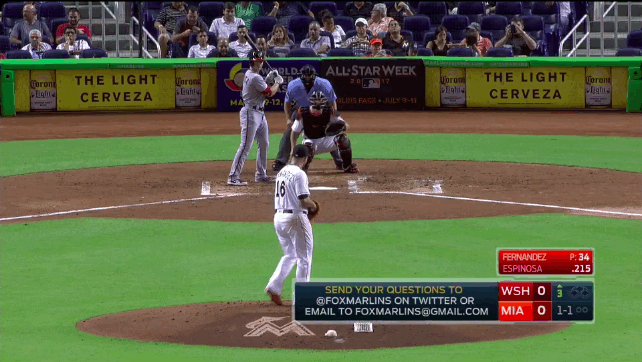
Fernández didn’t need the change-up for the next two hitters. He poured in fastballs to get a quick groundout from Tanner Roark, and then, after fouling off a couple heaters, Trea Turner squibbed one to Dee Gordon to close the inning.
Top of the 4th: Drew (K), Harper (F8), Rendon (K); 15 pitches
Fernández had some counts worked by Nats hitters in this frame, but it ultimately didn’t matter. Fernández got drunk on his change-up, laying in a called strike to Stephen Drew and then, after Drew climbed back into the count by spitting on two breaking balls and fighting off a couple fastballs, got him to chase another change.

By the time Fernández handed the ball over to David Phelps in the ninth inning, he had thrown the change-up exactly as much as the breaking ball. It was his calling card that night.
Harper’s line-out helped balance Drew’s double. Whereas Drew placed it perfectly on a ball that would have usually been caught, Harper whistled his into Christian Yelich’s territory. The ball came off the bat at nearly 103 miles per hour, but Yelich played deep enough that he didn’t have to break a sweat. The Nationals got a little taste of karma.
There was no messing around with Rendon. Three straight fastballs, none under 97 miles per hour. Fernández flirted with pitch count issues thanks to the Drew at-bat, but Rendon allowed him to keep things stable.
Top of the 5th: Robinson (F9), Ramos (Kc), Goodwin (K); 13 pitches
The fastball trend continued. Fernández got Goodwin to look at a change-up for a called strike, but for the most part, Fernández just poured in fastballs. He challenged hitters, and they couldn’t respond. He even got Ramos looking for strike three, the first backward-K of the night for Fernández. If you go 1-2-3 in the inning on 13 pitches and two strikeouts with almost nothing but fastballs, one could say you are, in a word, dealing.

What I love about that called strikeout against Ramos is how perfect that 98-mph fastball was: Tons of late movement, on the black, piped in at a speed nobody could catch up with if they tried. J.T. Realmuto, a poor pitch framer in the aggregate, even did a nice job of keeping his body still and subtly moving the glove back over the plate to make sure that umpire Phil Cuzzi didn’t make the wrong call.
Cuzzi didn’t, as you can see in this strike zone plot from Baseball Savant.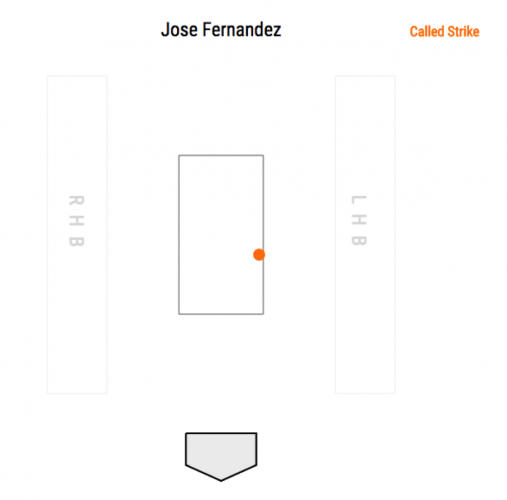
Realmuto had himself a quality outing, too. Fernández’s fastball command gave Cuzzi the comfort level to give some calls, like the 1-1 fastball to Brian Goodwin that made the count 1-2, but Realmuto did his part in presenting Fernández’s work in the best possible light. The battery was firing on all cylinders.
Top of the 6th: Espinosa (2-3), Roark (Kc), Turner (K); 11 pitches
The sixth inning was Fernández’s most efficient and most dominant inning of the game. Another 1-2-3 frame, another two-strikeout affair, and it took only 11 pitches to get the job done. It helped that Espinosa tried to bunt his way aboard on the first pitch. Whoops.
Meanwhile, both Roark and Turner made Fernández sing for his supper, but to no avail. Roark even worked a full count after Fernández missed on a couple of fastballs. The first should have been a strike. So too should that 2-2 curveball that Fernández missed upstairs with. Fernández reacted like he got the inside corner; he was right. The missed location probably led Cuzzi to call the ball, but still, Fernández threw two pitches he didn’t need to.
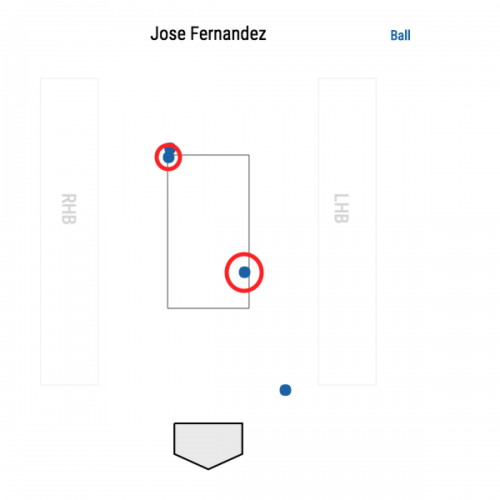
So, after a ton of gas, Trea Turner saw not a single fastball and became the ninth hitter to fan on the night. For all of Fernández’s bulldozing power, he never let you feel comfortable with what was coming next. Six innings down; two to go.
Top of the 7th: Drew (Kc); Harper (F8); Rendon (5-3); 12 pitches
The man who will be lost to history in this game is Tanner Roark. Despite walking three guys through the first five innings, Roark was as efficient as they come, He walked three guys in those five innings, but had thrown only 73 pitches by the time Giancarlo Stanton stepped up to the plate. Rich Waltz prophetically declared on the broadcast that Roark had allowed only 14 home runs in 31 starts up to that point. Stanton must have heard him. He promptly smacked a 100.2-mph, 31-degree, 374-foot solo shot over the right field wall. Fernández could now breathe a bit easier. Roark threw 86 pitches and seven innings when he finally exited the game, and instantly became Bob Hendley against Sandy Koufax in 1965.
Fernández continued his ruthless efficiency, mowing down Stephen Drew. Realmuto once again stole a called strike, bringing the glove down subtly and quickly to catch the letters. He later saved one at Drew’s knees, just on the lower edge of the zone, but without good glove work could have easily been called a ball. Realmuto was as in the zone as Fernández was all evening.
Fernández vs. Harper should be electric. The matchup pitted arguably the best left-handed bat against the best right-handed arm, on true talent. Indeed, Harper was one of the few to make consistently good contact on Fernández that night, and Yelich had to leg it out in order to snag Harper’s gapper. It didn’t matter; it was just one of those nights.
After Rendon’s groundout, Fernández had thrown 95 pitches. He was just over a year removed from his return after Tommy John surgery. He had this to say to Don Mattingly upon entering the dugout.
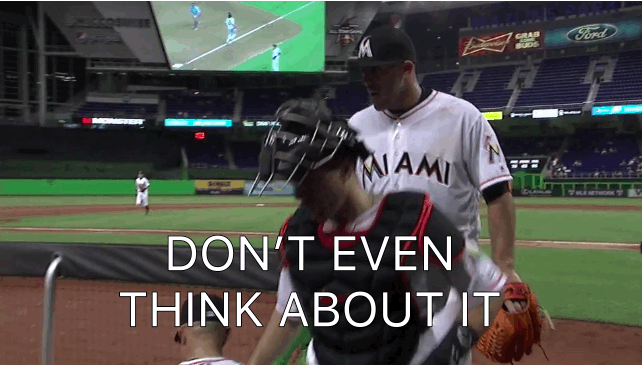
Mattingly complied.
Top of the 8th: Robinson (K), Ramos (1B), Goodwin (1B), Espinosa (K), Murphy (4-3); 16 pitches
You could tell Fernández was getting tired. His fastball sat at 95-96, rather than 97-98. Such was his fire that he battled all the way through it. Robinson went down easily enough, thanks to a couple pinpoint fastballs and a wipeout breaking ball, but Ramos finally got the better of him, rapping a single to center field, a textbook definition of a dying quail, whose weak exit velocity but optimal launch angle went for a hit more than 92 percent of the time in the last two seasons.
Goodwin’s hit, too, was a total fluke: 78 mph straight into the ground on the right side. There’s no reason Goodwin should have reached base safely, but for the ball chopping straight over Miguel Rojas’s head. Pinch runner Michael A. Taylor made it all the way to third. It was the first time Fernández was in trouble.
Before Ramos’ hit, Fernández had retired 21 straight hitters. Now, after a couple of legitimately fluke singles, pitching coach Juan Nieves came out for a long chat. Kyle Barraclough warmed in the bullpen. Fernández was determined to see the inning through, despite speed demon Taylor dancing on the third base line. The battle would continue.
And was it a battle. Perhaps it doesn’t appear so with hindsight—Danny Espinosa was put down on strikes and four pitches, while Daniel Murphy ground out to Dee Gordon—Fernández wore it all on his sleeve. He chucked six fastballs at Espinosa and Murphy, all 95 miles per hour. He used his change-up to get both hitters out. Three of those fastballs were fouled off. While neither guy could get Fernández’s pitch count up any more than was necessary, the ace was emptying the tank. An 0-2 fastball to Espinosa nearly went to the backstop, but for Realmuto’s snag. Philippe Petit himself could have danced on the stillness in the air with ease.
The air dissolved upon Fernández’s best change-up of the night to sit Espinosa down.

Murphy watched a fastball paint the black. He was pushed off the plate by a fastball in. He fouled off the third fastball into the seats. He then rapped a grounder to Dee Gordon. And that was all she wrote. Mama and abuela were ready.
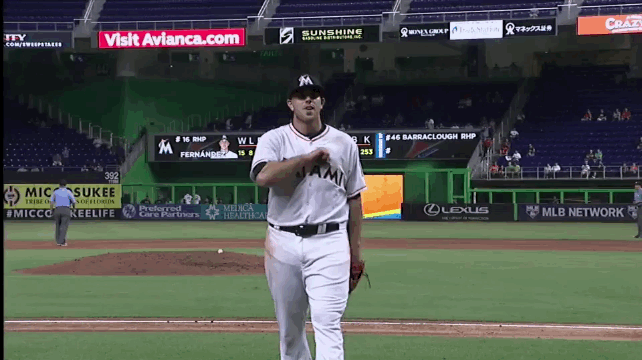
It is these moments that I will remember the most from this game. The love his family shows him, and the love he shows back; the hug Mattingly gives him after he enters the dugout for the final time; the mad shower of kisses hitting coach Barry Bonds rains upon him; the flexing of his biceps he flaunts for abuela in the stands. The game no longer matters. Only the love of those about whom he cared the most deeply is left.
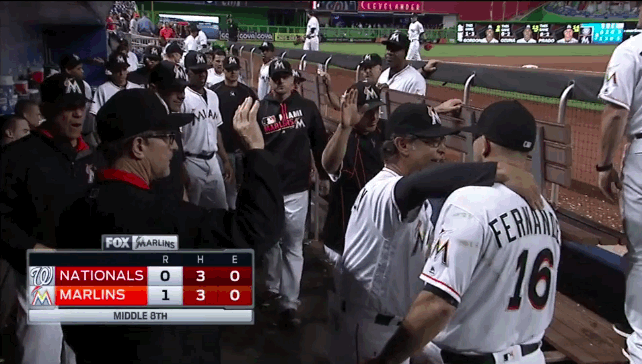
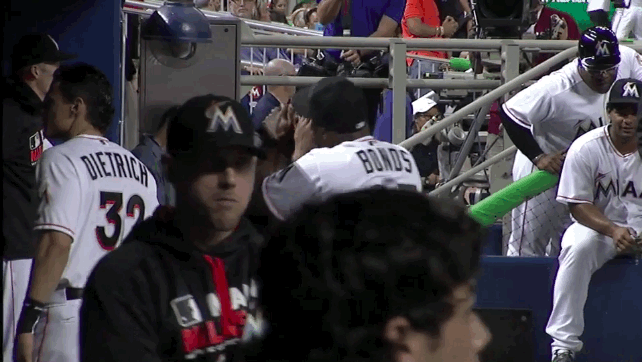
José Fernández is gone. Only 17,961 paying fans got to see his last go-round as a major league pitcher. More importantly, José Fernández the man will never again grace us with his presence. Only José Fernández the ballplayer remains. It seems uniquely like Fernández to make his last public memory his greatest; if only it were enough to salve the wound opened by the chasm of his absence.
I remember the game as a Nats fan, and how I felt sorry for Tanner Roark. However, I wasn’t at all surprised by the outcome of the game, because that was the magic of Jose Fernandez. Commentators certainly referred back to this game the day Fernandez died, because it was clearly so special.
Unfortunate for Roark, but if it took the best game of Jose Fernandez’ career to beat you 1-0, you pitched a hell of a game even if you got beat.
A very tragic loss. I read about the game after the death but I actually haven’t watched the whole game. I should be able to change that since they have the game online
https://m.youtube.com/watch?v=ZyuO9uWl2I8
Great article!
Thank you so so very much I miss hearing about Jose …
I didn’t know him personally but I knew of him I was sad for about a good month after he died . needless of what people say about him after finding out the cause, it doesn’t change the fact that he was one of the greatest baseball players of all time . His story in itself coming from Cuba all of his perseverance and all of his laughter, his heart and being so positive is what made Jose Fernandez
So very unforgettable too many .
Again sincerely thank you for your article. If you can please post when his baby girl is born that will be amazing .
Christina
I loved to see him play and his enthusiasm with the game and in the dugout with the team. I cried his death like he was my own, little did I know that short of 3 months later I was going to loose my 21 yrs old grandson in a car accident also a good baseball player for Nova University. I have faith that Jose and Dallas are now in God’s team in heaven.
Thank you for a transcendent article that satisfies on every level, esp in our yearning to see Jose on the mound one more time. Thank you!
It took me 5 days to get the courage to read this because it was so tragic. And this is coming from a Braves fan.
In 1983, the introduction of the Nintendo Entertainment System revitalized the gaming industry and changed its outlook forever. IGN’s #1 ranked gaming console of all-time returned to headlines last holiday season, when a mini version hit retail and became one of the year’s hottest Christmas gifts.